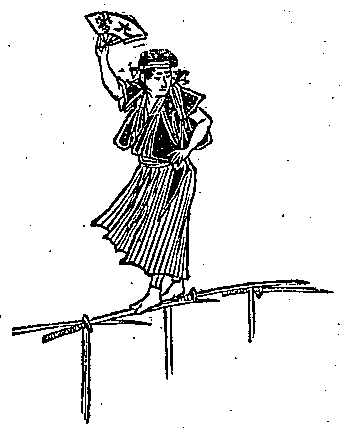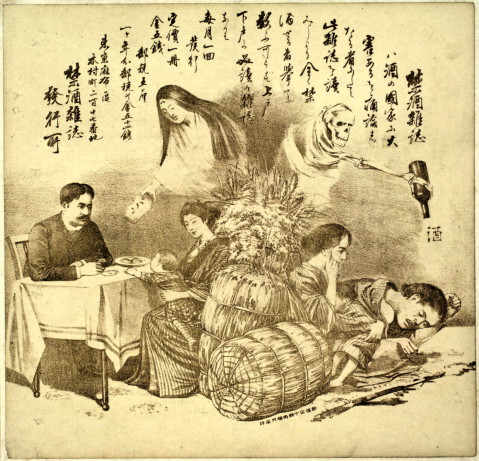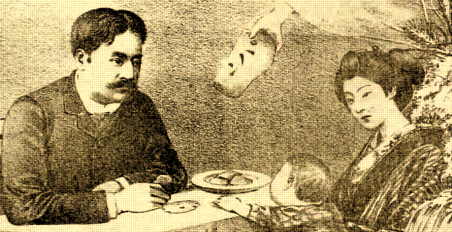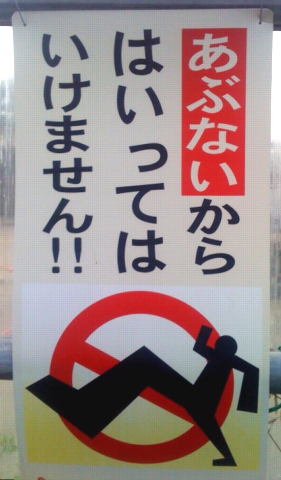Tsurugi watari
Joe Nickell's Secrets of the Sideshows sez:
In ancient times, walking on swords was a Shinto ordeal called Tsurigi Watari [sic!]. However, after Japanese conjurers learned the secret, the Shinto priests abandoned the rite. Later, Far Eastern performers brought the feat to Western audiences (Gibson 1967, 91). Resembling a stepladder consisting of five to seven rungs of broad swords placed edge upward, the ladder of swords is a sideshow mainstay.
"Gibson 1967" is Secrets of Magic: Ancient and Modern, which I do not own and cannot Google Book, so I can't trace the claim further back. But the intended word is obviously tsurugi watari 剣渡り, "sword-walking". (Tsurigi watari would be less thrilling.)
Here's a photo-filled blog entry about firewalking (火渡り) and swordwalking (剣渡り) at Fukan Reijō 普寛霊場 shrine, near Honjō station in Saitama. This event takes place on April 10th every year to celebrate the birthday of Fukan Jonin 普寛上人 ("the Great Fukan"), who "opened" (first climbed) the Mt Ontake in Chichibu nearby. (It all has to do with Ontake kyō 御嶽教; more; more. My knowledge is woefully incomplete here.)
There's a great written account of this event an appendix to Carmen Blacker's The Catalpa Bow. I also found an account of swordwalking at another shrine in Percival Lowell's 1895 Occult Japan, or the way of the gods. I quote:
Nothing now led up to the goal of this acrobatic pilgrimage but the consecrated ladder of sword-blades. Ad astra per aspera with a vengeance. Nevertheless the Chief of God-Arts, calling once more upon the gods, prepared to mount. Girding up his loins that his feet might not catch in his tunic, and grasping parts of the upper blades with his hands, he planted one foot lengthwise along the lowest sword-edge, and then, drawing himself up to its level, placed the other similarly on the blade above. Then he rose in like manner to the third rung, and the fourth, and so on heavenward. He did this carefully but deliberately. Evidently it was merely a question of foot-placing with him.
The higher he got the less he seemed to think of his footing and the more of effect, till in mid-ascent he was minded to try a religious pas seul. Posing on one foot, he turned deftly to face the crowd, and with the appropriate swing kicked out with the other high into the air, flaunting his foot before the rapt concourse of people in the most approved prima assoluta manner. At this unexpected terpsichorean touch the populace burst into applause; and the Chief of God-Arts, turning triumphantly to his climb, continued boldly up till amid a general gasp of relief from the crowd below he topped the last rung and stepped out unscathed upon the platform.
Lowell also offers an increasingly embarrassing (for the modern reader) analysis of the workings of this "miracle":
Doubtless credulity is the mother of miracles, but doubtless, also, with the far eastern family of them a pachydermatous sole step-fathers the process. For most of them are questions of cuticle. Of the three great Shinto rites: the Ordeal by Boiling Water; the Walking across Live Coals; and the Climbing upon Sword-blades, all depend upon it for easy performance. That the average Japanese sole is equal to the feat without preliminary purification is evident from the success of my boy, who simply picked up his skirts and walked.
But a certain other physical fact enters this last miracle not commonly appreciated, to the innocent manipulation of which by the priests the miracle is due; to wit, the immense difference in cutting power between a stationary and a moving blade. Everybody is aware that there is a difference, but few people realize how very great it is. If you press your finger upon the sharp edge of your knife, you will be surprised to find what a pressure you can put upon it with impunity; but if, ever so gently, you draw the knife-blade across the skin, it instantly sinks in.
The principle involved is the principle of the wedge. By drawing the blade along in the direction of its edge at the same time that you press down, you thin its angle to any desired tenuity. You have but to graduate the horizontal motion to the vertical force. As the angle of the wedge thus sharpens, the force necessary to make it enter is lessened indefinitely. We unwittingly apply this principle whenever we cut anything. And as this is our normal state, we forget that the blade is, statically used, not as cutting as we think.
Furthermore, it will be remembered that, as a rule, the priests took heed in placing their feet. Most of them were careful to minimize the impact.
These are some of the points that make miracle-working possible; but a good audience is equally necessary. A sympathetic populace renders Japan a very paradise of miracles. There is thus a twofold reason for a miracle's success; a thicker skin in the priests, and a thicker skull in the people. This double lack of penetration makes it easier both to do, and to be done by, a miracle than it would be elsewhere.
Pondering in this wise upon the great advantages for successful miracle-working possessed by priests of an artistic, pachydermatous people over those of a thin-skinned, scientific one, and half lamenting the lost grandeur of that pious past whose childish imaginings loomed so large and life-like, and vanish so sadly before our bull's-eyes of search, we were rolled through the broad quiet twilight of tillage toward the growing twinkle of the town.
Oh, well, it wouldn't be a 19th-century book about Japan without racism. (For what it's worth, Nickell's explanation of the trick is the same as the physics-based part of Lowell's.)
As for conjurers, tsurugi watari is one of the tricks included in Kairyō kijutsu 改良奇術 ("Improved Magic"), a book written in 1905 by Matsui Shōyōsai 松井昇陽斎. (Source: This handy site with info on Japanese magic books by decade.) Kairyō kijutsu is even in the online Diet library. Here's the part about swordwalking:

先づ圖のごとく、明皓々たる剣を連ねて架け渡し、「さて是れより此の剣の上を渡りてお目に掛けますが、幸に傷をも受けぬ時は、何卒喝采を願ひます」とて、扇をひろげて中心點を失はざるやうになし、足拍子面白く渡りて、又舊の所に歸り来り、幾回も往復し、看客をして心胆を寒からしむべし。
●種明し 此の技を演ずるときは、技師は、足袋を穿つこと勿論なるが、足袋の底には、堅固なる金網を入れ置き、刀傷を受けざる様に注意するものなり。
First, make a walking bridge of a line of bright, shining swords as shown in the diagram. Next, say "I shall now walk across these swords before your very eyes, and, should I be so fortunate as to receive no injury, I ask for your applause," spread out your fan so as not to loose your center, and then walk across and then back with an amusing step, repeating this several times, and so chill the innards of your audience.
The secret: When performing this trick, professionals are of course wearing tabi (toed socks); but in the sole of their tabi they insert a tough wire mesh, so as not to receive injury from the blades.
So, wire-mesh socks are also a good way to perform this trick, but only if you can master the much more difficult art of finding people who will be impressed by you walking on dangerous things non-barefoot.
![[No-sword]](http://no-sword.jp/images/site/no-sword_banner.jpg)






